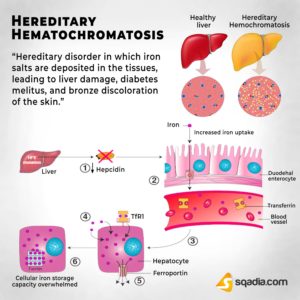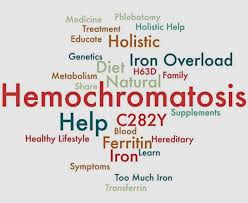Hemochromatosis is a disorder where too much iron builds up in your body. Sometimes it’s called “iron overload.” Hemo meaning blood and chromatosis means pigmentation specifically : deposit of pigment in a normally unpigmented area or excessive pigmentation in a normally pigmented site.
Normally, your intestines absorb just the right amount of iron from the foods you eat. But in hemochromatosis, your body absorbs too much, and it has no way to get rid of it. So, your body stores the excess iron in your joints and in organs like your liver, heart, and pancreas. This damages them. If it’s not treated, hemochromatosis can make your organs stop working.
There are two types of this condition — primary and secondary.
Primary hemochromatosis is hereditary, meaning it runs in families. If you get two of the genes that cause it, one from your mother and one from your father, you’ll have a higher risk of getting the disorder.
Secondary hemochromatosis happens because of other conditions you have. These include:
- Certain kinds of anemia
- Liver disease
- Getting a lot of blood transfusions
- White people of northern European descent are more likely to get hereditary hemochromatosis. Men are 5 times more likely to get it than women.
Symptoms
Up to half of people who have hemochromatosis don’t get any symptoms. In men, symptoms tend to show up between ages 30 and 50. Women often don’t show signs of this condition until they’re over 50 or past menopause. That may be because they lose iron when they get their periods and give birth.
Symptoms of hemochromatosis include:
- Pain in your joints, especially your knuckles
- Feeling tired
- Unexplained weight loss
- Skin that has a bronze or gray color – pigmentation
- Pain in your belly
- Loss of sex drive
- Loss of body hair
- Heart flutter
- Foggy memory
Sometimes people don’t get any symptoms of hemochromatosis until other problems arise. These may include:
- Liver
- Diabetes
- Abnormal heartbeat
- Arthritis
- Erectile dysfunction (difficulty having a erection)
If you take a lot of vitamin C or eat a lot of foods that contain it, you can make hemochromatosis worse. That’s because vitamin C helps your body absorb iron from food.
White people of northern European descent are more likely to get hereditary hemochromatosis. Men are 5 times more likely to get it than women.

